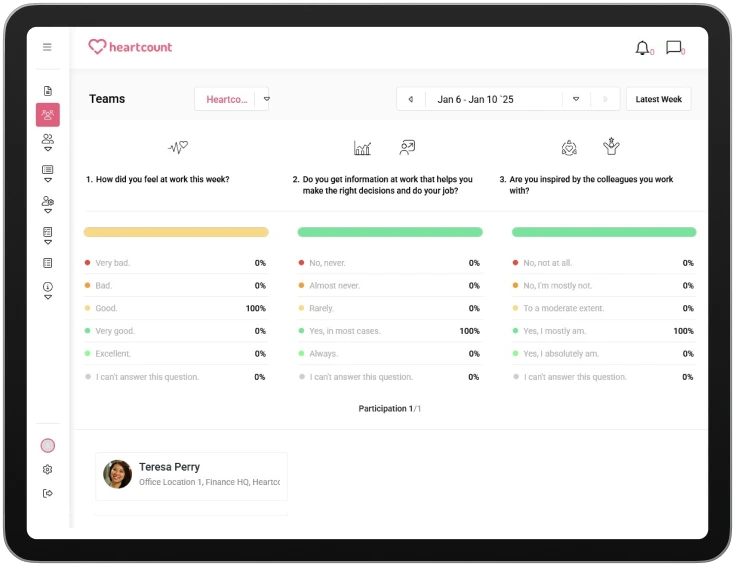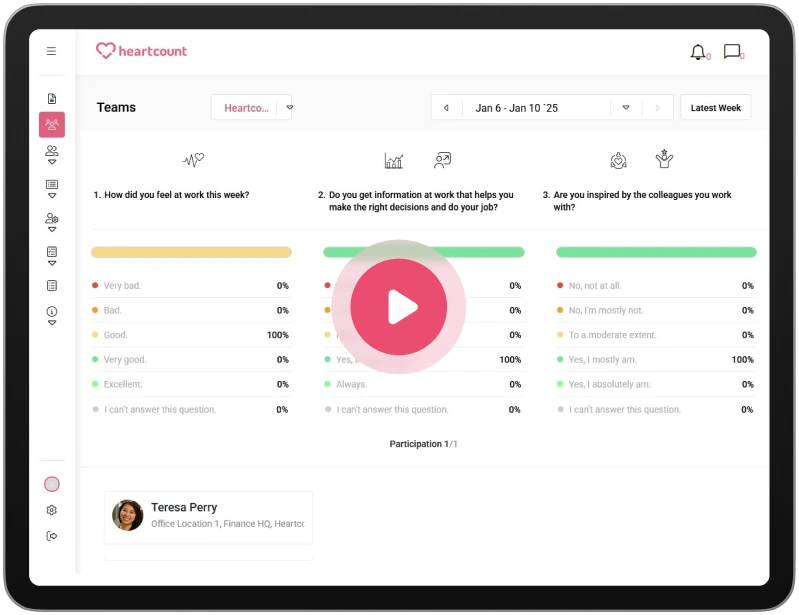Everything You Should Know When Choosing an Employee Experience Platform

In today’s workplace, prioritizing employee engagement and well-being is crucial. Many companies turn to HR tech to achieve this.
However, not all platforms are the same and may fail to deliver tangible results. This often occurs when they do not meet the specific needs of your organization and lack customization, advanced metrics, and clear ways of measuring ROI.
To avoid this, it’s important to understand an employee experience platform, how it differs from traditional HR tools, and how its features can actually improve your workplace culture.
-
1.What is an employee experience platform (EXP)?
-
2.The benefits of using an employee experience platform
-
3.The most common features of digital employee experience platforms
-
4.Key security considerations for employee experience software
-
5.How to set up an employee experience platform in your organization?
-
6.Measuring the impact and ROI of employee experience software
-
7.Try before buy
In today’s workplace, prioritizing employee engagement and well-being is crucial. Many companies turn to HR tech to achieve this.
However, not all platforms are the same and may fail to deliver tangible results. This often occurs when they do not meet the specific needs of your organization and lack customization, advanced metrics, and clear ways of measuring ROI.
To avoid this, it’s important to understand an employee experience platform, how it differs from traditional HR tools, and how its features can actually improve your workplace culture.
What is an employee experience platform (EXP)?
An Employee Experience Platform (EXP) is software designed to facilitate how organizations interact and communicate with their employees. It consists of various features that help organizations track experiences throughout the entire employee journey, providing real insight into their well-being, motivation, happiness, engagement, and overall employee experience.
Unlike traditional HR systems that focus on administrative tasks, an employee experience platform prioritizes the daily experiences of your team members. This plays a significant role in improving employee morale and ensuring a positive employee experience.
It’s like continuously conversing with your team members, constantly keeping them in the loop, understanding their needs, and acting on real-time employee feedback. It’s a fire-safe way of building trust and transparency while reducing uncertainty and employee burnout.
Think of it as a blueprint for creating a more responsive and supportive work environment where your employees feel valued and informed, driving higher motivation, productivity, and team culture.
An employee experience platform can help you digitalize the following processes:
- Performance management – streamlines employee performance reviews thanks to continuous feedback and precise goal-tracking.
- Communication channels – enhances management and internal communication with an array of features.
- Onboarding and training – digitalizes the employee onboarding process and provides ongoing resource library so that your employees have the access to necessary knowledge base they need.
- Career development – supports career growth with personalized employee development plans and learning opportunities.
- Employee recognition – implements peer-to-peer recognition programs to celebrate employee achievements and foster a culture of appreciation.
This directly helps your organization by having a stronger impact on:
- Clearer career development paths, higher employee productivity, and better alignment of employee’s individual goals with organizational objectives.
- Reducing misunderstandings, increasing transparency, and creating a more cohesive team environment.
- Faster integration of new hires, ongoing skill enhancement, and a more competent and adaptable workforce.
- Increased employee satisfaction, and loyalty, while reducing turnover by providing clear career development opportunities.
- Employees feel valued, which boosts employee morale and motivation, leading to improved performance and job satisfaction.
How do employee experience platforms work
Employee experience platforms (EXPs) use different features to help organizations understand employee sentiment, collect feedback, and facilitate communication between employees and management.
They typically have a centralized dashboard that provides an overview of different employee engagement categories measured through custom or automated surveys. Also, they often include features for employee feedback, comments, and goals.
For example, HeartCount conducts weekly pulse surveys that cover several categories of employee engagement, including well-being, personal advancement, job satisfaction, attitude towards the company, relationship with management, relationship with colleagues, employee productivity and efficiency, feedback, and recognition.
The responses are collected and analyzed in real-time, providing HR managers with immediate insights and people analytics through user-friendly dashboards. On the spot, managers can quickly identify disengaged teams and individuals and address any issue.
HeartCount employee engagement survey includes 140 scientifically validated questions that precisely pinpoint the current climate in your company and teams. This enables managers to recognize disengaged employees and act on feedback.
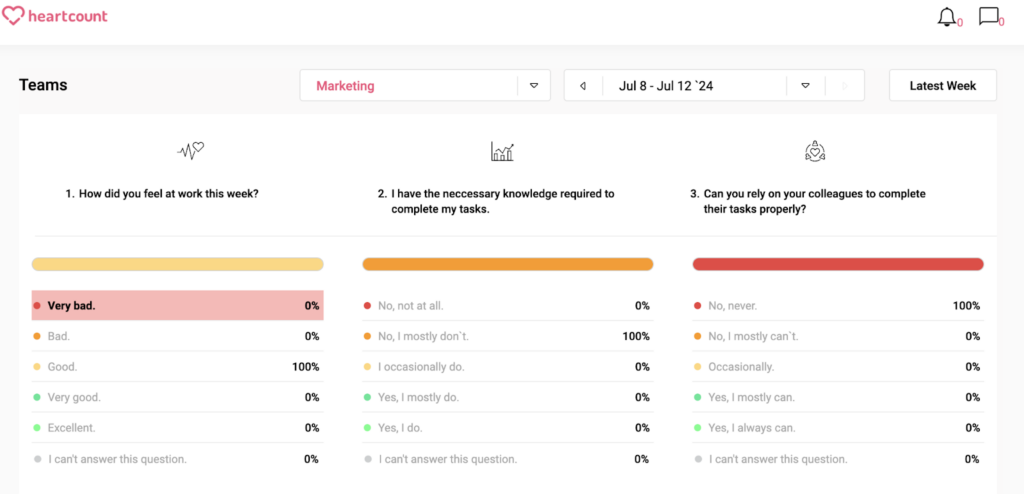
What’s the difference between an employee experience platform (EXP) and a human resource management system (HRMS)?
The main difference between employee experience platforms (EXP) and Human resource management systems (HRMS) lies in their focus areas.
Digital employee experience platforms enhance overall employee engagement and satisfaction through real-time feedback, pulse surveys, peer recognition, and sentiment analysis.
HRMSs manage administrative HR tasks and processes, such as payroll processing, employee records management, benefits administration, and compliance tracking.
Both are essential tools for HR professionals but serve two completely different purposes.
If you’re still struggling to separate those two, here’s a quick rundown of the main differences:
| Aspect | Employee Experience Platform (EXP) | Human Resource Management System (HRMS) |
| Purpose | Enhances overall employee engagement and satisfaction | Manages administrative HR tasks and processes |
| Use Cases | Real-time feedback, pulse surveys, peer recognition, employee sentiment analysis | Payroll processing, employee records management, benefits administration, compliance tracking |
| Benefits | Improves employee engagement, identifies and addresses issues quickly, fosters a culture of recognition | Streamlines HR operations, ensures regulatory compliance, and manages employee data efficiently |
The benefits of using an employee experience platform
- Increased employee engagement: Regular pulse surveys keep employees engaged and provide continuous feedback.
- Timely decision-making: Real-time insights empower HR professionals to make better-informed decisions promptly, ensuring that issues are addressed effectively.
- Cost savings: Improved retention reduces operational hiring costs, saving significant organizational resources.
- Enhanced communication: Transparency and communication within the organization improve, creating a more cohesive and collaborative work environment.
- Data-Driven HR: Processes are optimized, and decisions are made based on real-time data.
- Employee well-being: There’s no more second-guessing knowing how your team feels and what drives them.
- Predictive retention metrics: Early identification and mitigation of turnover risks help retain top talent and maintain your organizational stability.
COLLECT
The most common features of digital employee experience platforms
Digital employee experience platforms have significantly evolved. They have shifted from being perceived as another over-promised HR tool to actually making a real difference within your organization. With that transformation, they’ve introduced a variety of features and functionalities.
Here are some of the most important features to consider when choosing an employee experience platform:
Employee surveys
A key feature of effective employee experience platforms is the ability to conduct regular employee surveys and collect feedback.
For instance, HeartCount sends weekly pulse surveys that take seconds to complete, providing invaluable insights into employee engagement. This frequent feedback loop helps HR managers stay connected with their team and address issues promptly.
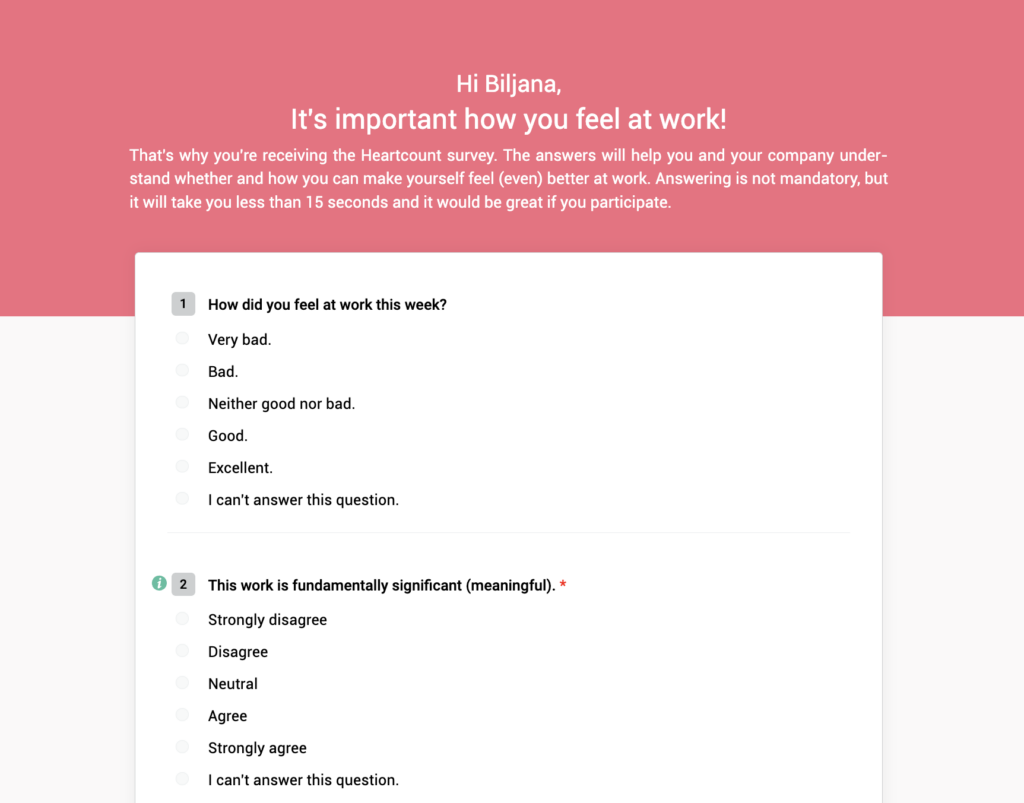
Employee feedback and recognition
Considering that implementing an employee recognition program can reduce voluntary turnover by 31%, it’s not surprising that employee recognition is one of the crucial features of any employee experience app.
The primary goal is to make employees feel valued and appreciated for their work.
HeartCount’s peer-to-peer recognition feature makes it easy for colleagues to acknowledge each other’s contributions.

Analytics and insights
Today’s world belongs to data! More pristine employee experience software provides rich dashboards and advanced analytics, giving you deep insights into employee engagement, productivity, and overall sentiment.
For example, with HeartCount you get the following data analytics tools:
| Analytics Tool | Description |
| Real-Time Insights | Provides managers with immediate access to data through user-friendly dashboards. |
| Rich Dashboards | Advanced KPI dashboards, sentiment scores, and customizable views for comprehensive insights. |
| Predictive Retention Metrics | Tools for identifying and mitigating turnover risks early. |
| Participation Rate Tracking | Overview of team and individual participation in surveys over time. |
| Data Filtering | Filters to analyze results based on various factors. |
| Individual and Team Overviews | Visual snapshots of individual and team performance and engagement. |
| Retroactive Insights | Overall engagement score and pattern analysis to help spot trends and inform decisions. |
Key security considerations for employee experience software
There are dozens of critical areas you need to focus on to ensure your data and privacy are well-protected.
- Data Encryption
One of the first things to look for in an employee experience app is data encryption. It’s crucial that all data, whether it’s being sent or stored, is encrypted.
A publicly available document, the Data Processing Record, contains information on how the platform processes your company’s data.
You can probably find it in the website’s footer or listed between legal documents. If not, request it before you sign up for the services.
- Access Controls
Access controls mean that only authorized personnel can access sensitive information, reducing the risk of data breaches. This approach helps maintain employee data security by ensuring that only those with a legitimate need view or modify it.
For example, HeartCount uses role-based access control to limit data access based on job responsibilities.
- User Authentication
Strong user authentication methods like multi-factor authentication (MFA) significantly improve security.
MFA requires users to provide two or more verification factors before accessing the system. This adds an extra layer of protection, even if someone’s login credentials are compromised.
- Compliance with Regulations
Compliance with data protection regulations like GDPR, HIPAA, and CCPA should always be a priority. By demonstrating a commitment to data security, it builds trust with its users and HR specialists.
- Data Anonymization
Data anonymization techniques are vital for protecting employee identities in survey results.
With HeartCount, employees to provide honest feedback without fear of being identified. This encourages open communication and more accurate insights.
How to set up an employee experience platform in your organization?
Here are the eight steps on how to set up an employee experience platform in your organization:
1. Define Your Goals
Start by identifying what you aim to achieve with the platform. Are you looking to boost employee engagement, improve communication, or reduce turnover?
Every organization has different goals in mind.
2. Customize the Platform to Your Needs
Pick a platform that is highly customizable. It gives you ultimate control, allowing you to tailor surveys, feedback mechanisms, and reporting tools to suit your organization’s specific requirements.
You should ensure the platform aligns perfectly with your organizational goals.
For example, with HeartCount, you can create custom surveys, tailor questions, schedule their distribution, and target specific teams or individuals.
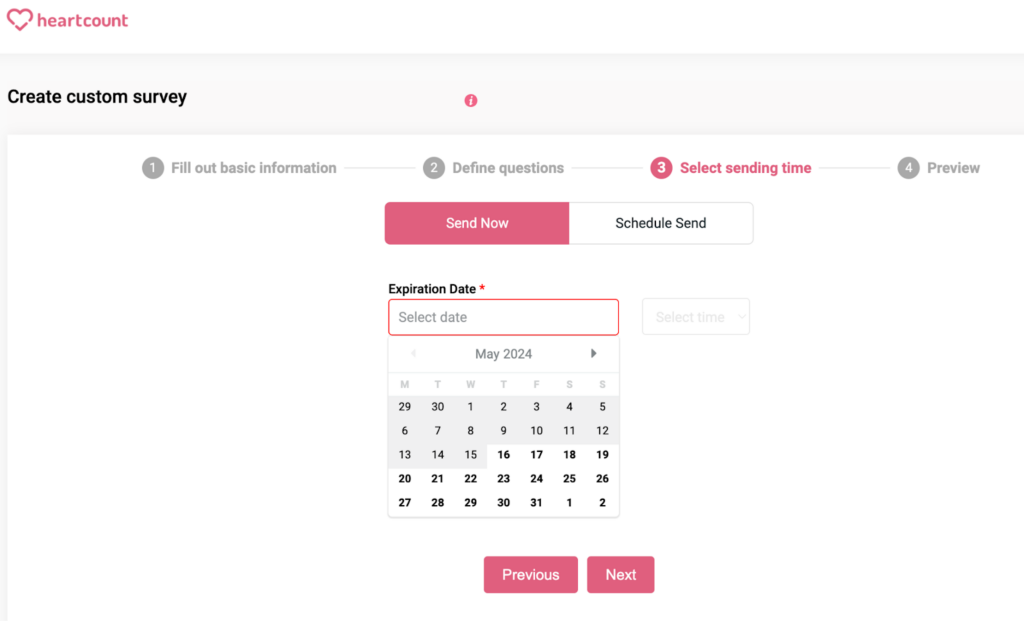
3. Plan the Implementation
This should include timelines, key milestones, and responsibilities.
Break the process into manageable phases.
Consult with a provider about what part of implementation you must do, and what is solely their responsibility.
4. Train Your Team
Once the employee experience app is up and going, both your administrators and employees will need training.
For example, HeartCount offers onboarding support to ensure everyone is comfortable using the platform. Training sessions cover everything, from using the platform’s features and interpreting data to responding to feedback. This positively impacts the response rate.
5. Monitor and Adjust
Use real-time insights and analytics to track participation rates, employee engagement, and other key metrics.
However, the most important thing is to be ready to make adjustments based on feedback and changing needs.
No monitoring or analytics will make the change in your organization if you’re not ready to move the needle first.
6. Act on feedback
Encourage a culture where feedback is valued more than anything and acted upon. Use the insights gained from HeartCount to make informed decisions and become a leading example of how your employees’ input directly creates positive changes.
7. Evaluate and Iterate
The core of every digital employee experience platform is that you have to evaluate the platform’s impact against your initial goals constantly.
Use HeartCount’s detailed reports to measure improvements in engagement, communication, and overall satisfaction.
UNDERSTAND
Measuring the impact and ROI of employee experience software
Here’s a simple way of measuring the impact and ROI of employee experience software:
| Aspect | Description |
Engagement Metrics | Regular pulse surveys provide a clear picture of how our engagement initiatives are working. Gallup’s study shows that businesses with engaged employees have 10% better customer ratings and 18% higher sales. |
Productivity Data | Engaged employees perform better and are more innovative. Their engagement can increase productivity by 18% and profitability by 23%. |
Turnover Rates | Engaged staff are less likely to leave their jobs. They save companies money for recruiting, hiring, and training new employees, which can total 10 to 30% of an employee’s annual salary. |
Performance Reviews | Better-informed reviews lead to more targeted development plans, which improve overall performance and morale. Businesses with high employee engagement grow their profit 3x faster and offer higher salaries. |
Culture Improvement | HeartCount helps you monitor shifts in cultural metrics, showing you how the platform supports a positive and productive work environment. Employees feel respected, needed, and connected to the company’s mission, which is key to business success. |
Try before buy
Sometimes, even if the platform is good in theory, it won’t be what you expected. So, it’s important to demo your chosen platform and see if it meets all your organization’s needs.
That’s why HeartCount offers you two weeks free. Start your free 14-day trial!







